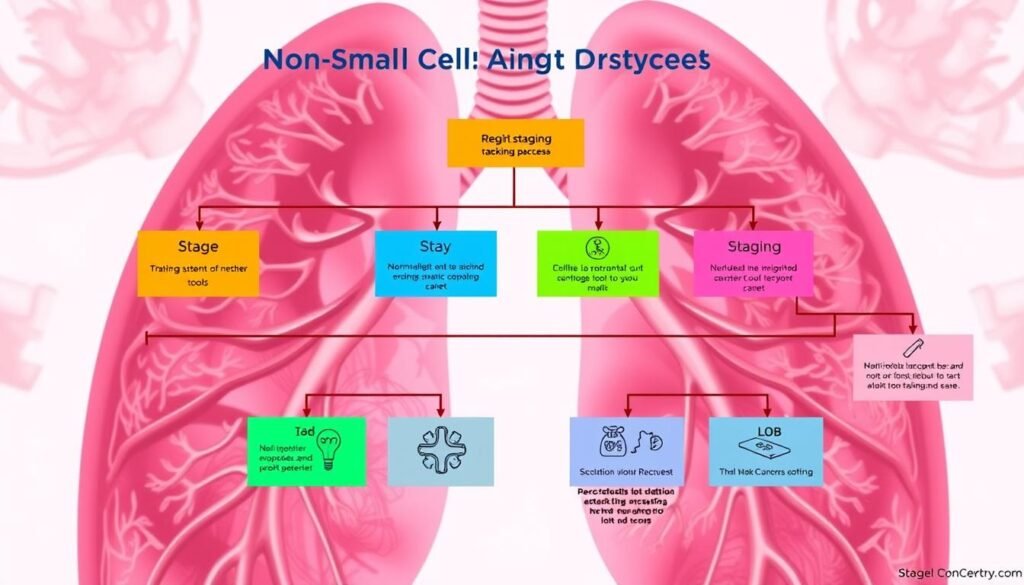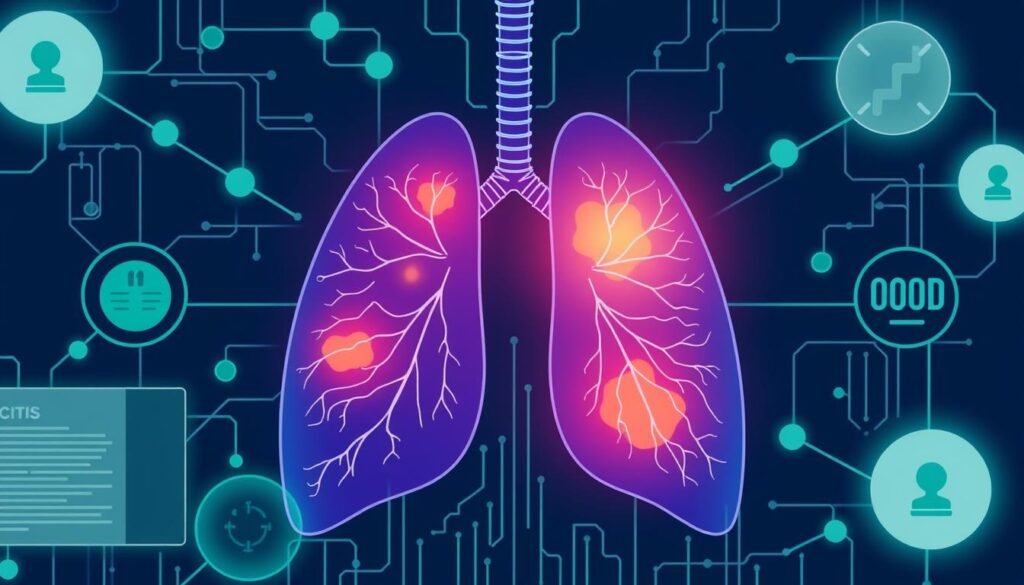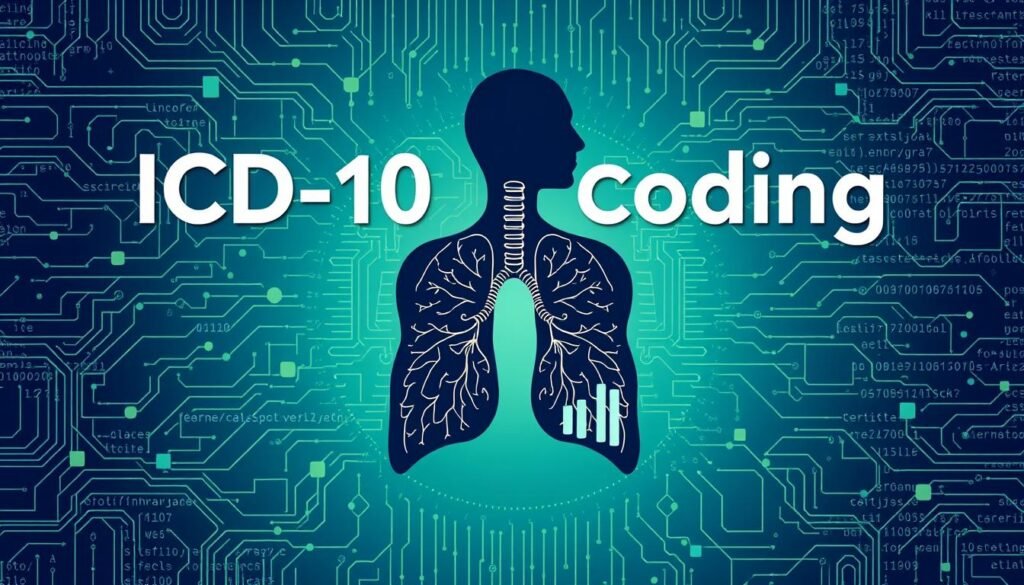Lung cancer, especially non-small cell lung cancer (NSCLC), makes up about 85% of all lung cancer cases. It’s really important to know the ICD-10 code for it. This code is key for doctors to diagnose and keep track of this common cancer accurately. Knowing this code is crucial because treatments and money matters depend on the right coding. This helps not just doctors but also patients who need fast and effective treatment.
The code for NSCLC is C34.91, starting October 1, 2024. It’s for cancer in a part of the right lung or bronchus that’s not specified. This code is part of important groups that deal with lung cancers of different seriousness. Getting these codes right is needed for correct paperwork and making sure insurance payments are made for treating non-small cell lung cancer.
Key Takeaways
- The ICD-10 code C34.91 specifies a malignant neoplasm in the right bronchus or lung.
- Lung cancer accounts for approximately 85% of cancer deaths in the United States.
- Accurate coding is essential for reimbursement claims starting from October 1, 2015.
- Different codes exist for various types and stages of lung malignancies.
- The code Z85.118 relates to the personal history of other malignant neoplasms.
- Being informed about ICD-10 codes enhances patient care and treatment planning.
Understanding Non-Small Cell Lung Cancer
Non-small cell lung cancer, known as NSCLC, is the main type of lung cancer. It includes different subtypes, each with unique traits. Knowing these types helps doctors treat patients better.
Definition and Types
About 85% of lung cancer cases are NSCLC, making it very common. It has three key subtypes:
- Adenocarcinoma: Usually found in the outer parts of the lungs, common in non-smokers.
- Squamous Cell Carcinoma: Often linked to smoking, located in the middle of the lungs.
- Large Cell Carcinoma: Less common and can be found in various places in the lungs.
This information helps doctors make better decisions for treatment, improving patient care.
Prevalence and Impact
NSCLC is very common, accounting for around 85% of lung cancer cases each year. It’s a leading cause of death from cancer, highlighting the need for better screening and early diagnosis.
Smoking and environmental factors increase the risk of NSCLC. Ongoing research for better treatments is key to fighting this disease.
Overview of ICD-10 Codes
The International Classification of Diseases, 10th Revision, or ICD-10, is important for coding medical diagnoses and procedures. It helps healthcare providers use a standardized approach to document patient conditions. The ICD-10 overview helps professionals understand code structures for proper billing and tracking diseases.
What is ICD-10?
ICD-10 is a coding system made by the World Health Organization. It assigns codes to a variety of health issues, aiding clear communication among healthcare pros. With precise codes, we can track treatment results and perform detailed statistical analysis. This system boosts data management in healthcare and supports public health research.
Importance of Accurate Coding
Correct ICD-10 coding is very important. It ensures doctors get paid right by insurance, affecting a clinic’s money health. Good coding helps spot trends in how we give care and patient results, important for better care quality. Wrong codes can cause delayed payments and problems in patient care records.
| ICD-10 Code | Description |
|---|---|
| C34 | Malignant Neoplasm of Bronchus and Lung |
| C34.90 | Lung Cancer, Unspecified |
| C43 | Malignant Melanoma of Skin |
| C55 | Uterine Malignancies |
| C61 | Malignant Neoplasm of Prostate |
ICD-10 Code for Non-Small Cell Lung Cancer
The ICD-10 coding system is key for categorizing non-small cell lung cancer (NSCLC). These codes help with recording, planning treatment, and monitoring the disease. The code C34 points to cancer in the bronchus and lung. This helps doctors select the right treatments and handle insurance claims.
C34 – Malignant Neoplasm of Bronchus and Lung
The range for C34 code lung neoplasm spans from C34.0 to C34.9. Each code shows different lung cancer locations. Code C34.90 covers cancer in any lung or bronchus part that’s not specified. Knowing the exact cancer spot is crucial for targeted therapy. Codes also exist for when cancer spreads to other organs, which often happens in advanced stages.
Specific Codes for Non-Small Cell Lung Cancer
There are also specific ICD-10 codes for NSCLC that has spread. Here is a list:
| Code | Description |
|---|---|
| C78.00 | Secondary malignant neoplasm of lung |
| C79.31 | Brain metastasis |
| C79.51 | Bone metastasis |
| C79.71 | Adrenal gland metastasis |
Correct coding is crucial for cancer databases. They use this info to improve research on NSCLC. While ICD-10 doesn’t have codes for NSCLC types like squamous cell, details are often in medical records. This data aids in creating treatments and research. Understanding these codes, including the icd 10 code for nsclc, helps doctors care for patients well.
Lung Cancer ICD-10 Codes
Coding for lung cancer is key for the right treatment and care. Knowing the ICD-10 codes for lung cancer is crucial. It helps spot the diagnoses and pick the best treatments. These codes vary by the cancer type and its stage, giving doctors a full plan to tackle this illness.
General Lung Cancer Coding
Non-Small Cell Lung Cancer falls mainly under C34. It makes up about 85% of lung cancer cases. There are special codes for different tumor locations, like:
- C34.0 – Main bronchus
- C34.1 – Upper lobe
- C34.2 – Middle lobe
- C34.3 – Lower lobe
- C34.9 – Unspecified part of the lung
Accurate coding is very important. It shapes the treatment plan and the expected results. The survival rate for Non-Small Cell Lung Cancer changes a lot by stage. For early cases, it’s about 59%. But it falls to 6% for advanced stages with distant spread.
Coding for Different Stages of Lung Cancer
The ICD-10 system makes clear differences for coding lung cancer stages. It has specific codes for each stage. This helps doctors create personalized treatments. For instance, C34 codes pinpoint the cancer’s spot, which helps decide on interventions. Using these codes well, along with noting tobacco use, leads to better care and outcomes.
Accurate staging is a must for proper cancer management. It ensures the treatment matches the diagnosis. Clinicians can then offer the best care to those battling this tough disease.
| ICD-10 Code | Description | Stage |
|---|---|---|
| C34.0 | Main bronchus | Early |
| C34.1 | Upper lobe | Early |
| C34.2 | Middle lobe | Early |
| C34.3 | Lower lobe | Early |
| C34.9 | Unspecified lung | Any |
ICD-10 Code Lung Neoplasm Classifications
The ICD-10 coding system covers various lung neoplasm classifications. These are crucial for healthcare providers. They distinguish between primary lung cancers and those that have spread. This ensures accurate patient care and record-keeping. Each icd 10 lung neoplasm classification has unique features. These features impact diagnosis, treatment, and insurance claims.
Classification Details
The ICD-10-CM codes include ones like C34.90 for unspecified lung areas. It applies to lung cancer NOS (not otherwise specified). The 2025 ICD-10-CM edition will maintain this structure from October 1, 2024. This allows for consistent coding.
Characteristics of Each Code
Understanding the C34 code features is key for precise reporting. The characteristics of codes highlight specific lung neoplasm locations, such as:
| Code | Description |
|---|---|
| C34.0 | Main bronchus |
| C34.1 | Upper lobe of lung |
| C34.2 | Middle lobe of lung |
| C34.3 | Lower lobe of lung |
| C34.8 | Overlapping sites of bronchus and lung |
| C34.9 | Unspecified part of bronchus or lung |
Correct coding for lung cancer types is vital for effective treatment. It helps in tracking patient progress. The link between Chronic Obstructive Pulmonary Disease (COPD) and lung cancer highlights the importance of precise records. For more on coding non-small cell lung cancer, check out this link.
ICD-10 Code for NSCLC Staging
Non-small cell lung cancer staging is key for diagnosis and management. It uses the TNM classification system to check tumor size, nodal involvement, and distant spread. Each stage matches certain ICD-10 codes. These codes help doctors document how severe the cancer is and plan treatment.
Stage 1 to Stage 4 Coding
The process to stage NSCLC is shown in a table below. It lists ICD-10 codes for each stage:
| Stage | Description | ICD-10 Code |
|---|---|---|
| Stage 1 | Localized tumor in the lung | C34.90 |
| Stage 2 | Tumor larger or with local node involvement | C34.2X |
| Stage 3 | Advanced local disease with regional lymph node involvement | C34.8X |
| Stage 4 | Distant metastasis | C34.9X |
TNM Classification and Coding
The TN classification system helps doctors accurately stage NSCLC. It’s crucial for treatment choices and predicting outcomes. Using correct staging codes is essential. It helps understand how the cancer is advancing and to create effective treatment plans. Accurate coding also improves communication between medical professionals and focuses on the patient’s needs.

ICD-10 Code Carcinoma of Lung
Carcinomas are a type of cancer that starts in the skin or tissue lining organs. They are very important in cancer research. Regarding lung cancer, there are common kinds like squamous cell carcinoma and adenocarcinoma. These kinds help doctors understand lung cancer treatments and diagnoses better.
Understanding Carcinoma Types
It’s important to know the difference between carcinoma types and non-small cell lung cancer (NSCLC). ICD-10 codes, for example, the icd 10 code carcinoma lung, are key for proper record-keeping. Codes like C34 point to cancer in the bronchus and lung. This is linked to issues related to non-small cell lung cancer.
Relation to Non-Small Cell Lung Cancer
Knowing about lung carcinoma types is vital for treating it correctly. Non-small cell lung cancer includes several carcinomas. Using the right ICD-10 codes, like C34.9, helps in creating the best care plans. This code is for cancer in unspecified parts of the bronchus or lung, which is often seen in non-small cell lung cancer cases. Knowing about carcinoma types helps doctors care for lung cancer patients better, leading to improved outcomes.
ICD-10 Code for Primary Lung Cancer
Understanding primary lung cancer codes is key to good patient care and managing treatment. The icd 10 primary lung cancer code helps with precise diagnosis and deciding on treatment methods. Primary lung cancers start in the lung tissue itself. This means they have different codes than cancers that come from elsewhere. It’s important to get the coding right for proper treatment and payment for services.
Defining Primary Lung Cancers
Primary lung cancers come from lung tissues. They include types like adenocarcinoma, squamous cell carcinoma, and large cell carcinoma. The right ICD-10 codes are crucial for accurate record-keeping in healthcare. For example, the ICD-10 code C34.90 points to a malignant growth in an unspecified part of the lung or bronchus, starting October 1, 2024. Having the correct codes affects how doctors approach and manage care.
Difference Between Primary and Metastatic Lung Cancer
Distinguishing metastatic lung cancer is crucial for planning treatment. Metastatic cancers spread to the lungs from other parts of the body. In contrast, primary lung cancers begin in the lung tissues. Knowing the difference affects treatment plans and insurance payments.

Knowing the ICD-10 codes for primary and metastatic cancers improves care. Accurate coding lets providers monitor treatment better and understand patient history, like with the code Z85.9. Good coding promotes clear communication, improving care for lung cancer patients.
ICD-10 Code for Metastatic Lung Cancer
Metastatic lung cancer is key in patient care and treatment plans. Knowing the icd 10 code metastatic lung cancer is crucial for proper treatment. This coding helps healthcare professionals create effective treatment strategies for patients.
Identifying Secondary Lung Cancer
The main goal of coding metastatic lung cancer is to show it’s a secondary cancer. Codes like C78.00 and C78.01 mark the cancer’s secondary status. This is vital for diagnosis, prognosis, and planning treatments. Accurate coding also affects clinical reviews and care costs, making sure treatments match patient needs.
Impact on Treatment and Prognosis
Metastatic lung cancer requires a detailed treatment approach. Treatment implications are big, affecting how patients respond to therapy and their survival chances. The stats show that the 5-year survival rate is around 20.5%, which stresses the need for early detection and customized treatments.
Adding specific treatment info to the care plan can greatly improve patient results. It shows how right coding and treatment methods are closely linked. understanding these details can make healthcare better, support patient rights, and educate them.
Coding Guidelines and Best Practices
Healthcare providers must follow icd 10 coding guidelines closely. This ensures they comply and document accurately. Good documentation helps make coding more efficient and accurate. Providers and coders need to work together to understand these rules well.
Documentation Requirements
For coding to work well, you need accurate documents. Here are the key needs:
- Complete medical history and records of past treatments.
- Detailed info on the patient’s current health, including chronic conditions.
- A full review of the medical record to grasp the visit reason and treated conditions.
- Applying the rules and general coding guidelines from the ICD-10-CM Official Guidelines for Coding and Reporting.
These steps are crucial for correct ICD-10 code assignment. Following these guidelines matches healthcare laws and improves patient care.
Common Errors and How to Avoid Them
Errors in coding can mess up payments and affect patient health. Frequently seen mistakes are:
- Wrong codes due to misunderstanding the rules.
- Not documenting patient conditions well.
- Ignoring chapter-specific rules, which leads to wrong reporting.
To lower these mistakes, emphasize ongoing learning and regular guideline checks. Coders should get familiar with the 120-page document for FY 2024. It’s supported by four leading groups, including the American Hospital Association and CMS. Knowing and applying these rules well keeps coding in line with HIPAA. It also ensures coding is done right.

Conclusion
The ICD-10 code for non-small cell lung cancer is very important. It helps with correct clinical documentation and efficient payment processes. Healthcare workers need to keep up with changing coding rules. This ensures coding accuracy, affecting patient care and the financial health of medical facilities.
Understanding lung cancer’s coding is key to taking care of patients well. With precise codes, medical staff can choose better treatments and use resources wisely. Also, good coding supports research and looking into data. This helps make lung cancer treatments better over time.
Knowing how these codes affect patient care is crucial. By using the right ICD-10 codes, healthcare providers can improve the care they give. This leads to better survival chances and life quality for people fighting non-small cell lung cancer.